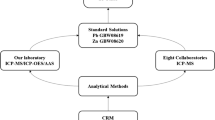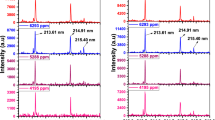Abstract
Waste polymer materials were analyzed by laser ablation inductively coupled plasma mass spectrometry (LA-ICP-MS). The concentrations of 35 elements were determined by using different types of external standards, namely glass and polyethylene (PE) based. Prior to the LA-ICP-MS analysis of determined elements, Na and/or Zn were used as internal standards. The investigations concentrated mainly on the detection of Cr, As, Cd, Sn, Sb, Hg, and Pb. Using PE-based calibration standards, the measured concentrations in the waste polymers were within 49% of the wet chemical data. The determined deviation was up to 102% when using the glass standards. Trace concentration of As and Hg (and also of S) could be determined with a concentration below 1 mg/kg. However, Hg provided very low intensity with a high relative standard deviation (RSD) and was therefore not further evaluated. Cryomilling of polymers was applied to reduce the particle size of the material and improved the precision and accuracy of LA-ICP-MS analysis. On average, the LA-ICP-MS results showed a deviation from the wet chemical reference analysis of 38% and an RSD of 56% for pressed polymer powder samples prepared by cryomilling. In general, waste pellets without sample preparation (i.e., use of pellets as delivered) are too heterogeneous, not suitable for micro-beam techniques, and showed a strong matrix dependence. With homogeneous pellets that appear similar to each other agreement in the determined concentrations was found for some elements.








Similar content being viewed by others
References
Fink H, Panne U, Niessner R (2001) Analysis of recycled thermoplasts from consumer electronics by laser-induced plasma spectroscopy. Anal Chim Acta 440:17–25
Fink H, Panne U, Niessner R (2002) Process analysis of recycled thermoplasts from consumer electronics by laser-induced plasma spectroscopy. Anal Chem 74:4334–4342
Radivojevic I, Niessner R, Haisch C, Florek S, Becker-Ross H, Panne U (2004) Detection of bromine in thermoplasts from consumer electronics by laser-induced plasma spectroscopy. Spectrochim Acta B 59:335–343
Wolf RE, Thomas C, Bohlke A (1998) Analytical determination of metals in industrial polymers by laser ablation ICP-MS. Appl Surf Sci 127:299–303
Resano M, Garcia-Ruiz E, Vanhaecke F (2005) Laser ablation inductively coupled plasma dynamic reaction cell mass spectrometry for the multi-element analysis of polymers. Spectrochim Acta B 60:1472–1481
Linsinger T, Liebich A, Przyk E, Lamberty A (2007) The certification of the mass fraction of, As, Br, Cd, Cl, Cr, Hg, Pb, S and Sb and the assignment of indicative values for Sn and Zn in two polyethylene reference materials. Report EUR 22784 EN. Office for Official Publications of the European Communities, Geel
Bürgler T (2008) Kunststoffe im Hochofenprozess - Vorbereitung, Umsetzung und Ergebnisse. Proceedings of 9th DepoTech conference, Leoben, Austria, November 2008
Asanuma M, Ariyama T, Sato M, Murai R, Nonaka T, Okochi I, Tsukiji H, Nemoto K (2000) Development of waste plastics injection process in blast furnace. ISIJ Int 40:244–251
Buchwalder J, Scheidig K, Schingitz M, Schmole P (2006) Results and trends on the injection of plastics and ASR into the blast furnace. ISIJ Int 46:1767–1770
Stepputat M, Noll R (2003) On-line detection of heavy metals and brominated flame retardants in technical polymers with laser-induced breakdown spectrometry. Appl Opt 42:6210–6220
Tanaka T, Ando Y, Saitoh T, Hiraide M (2002) Preconcentration of traces of cobalt, nickel, copper and lead in water by thermorespons ive polymer-mediated extraction for tungsten filament electrothermal vaporization-inductively coupled plasma mass spectrometry. J Anal At Spectrom 46:1556–1559
Park K, Lee JH, Cho K, Min HS, Lim MC, Choi DS (2008) Determination of toxic elements in polymer materials using instrumental neutron activation analysis. Bull Korean Chem Soc 29:1391–1394
Durrant SF, Ward NI (2005) Recent biological and environmental applications of laser ablation inductively coupled plasma mass spectrometry (LA-ICP-MS). J Anal At Spectrom 20:821–829
Günther D, Frischknecht R, Heinrich CA, Kahlert HJ (1997) Capabilities of an argon fluoride 193 nm excimer laser for laser ablation inductively coupled plasma mass spectometry microanalysis of geological materials. J Anal At Spectrom 12:939–944
Jarvis KE, Williams JG (1993) Laser ablation inductively coupled plasma mass spectrometry (LA-ICP-MS): a rapid technique for the direct, quantitative determination of major, trace and rare-earth elements in geological samples. Chem Geol 106:251–262
Koch J, Günther D (2007) Femtosecond laser ablation inductively coupled plasma mass spectrometry: achievements and remaining problems. Anal Bioanal Chem 387:149–153
Motelica-Heino M, Le Coustumer P, Thomassin JH, Gauthier A, Donard OFX (1998) Macro and microchemistry of trace metals in vitrified domestic wastes by laser ablation ICP-MS and scanning electron microprobe X-ray energy dispersive spectroscopy. Talanta 46:407–422
Jimenez MS, Gomez MT, Castillo JR (2007) Multi-element analysis of compost by laser ablation-inductively coupled plasma mass spectrometry. Talanta 72:1141–1148
Plotnikov A, Vogt C, Wetzig K, Kyriakopoulos A (2008) A theoretical approach to the interpretation of the transient data in scanning laser ablation inductively coupled plasma mass spectrometry: Consideration of the geometry of the scanning area. Spectrochim Acta B 63:474–483
Dobney AM, Mank AJG, Grobecker KH, Conneely P, De Koster CG (2000) Laser ablation inductively coupled plasma mass spectrometry as a tool for studying heterogeneity within polymers. Anal Chim Acta 423:9–19
Kang D, Amarasiriwardena D, Goodman AH (2004) Application of laser ablation-inductively coupled plasma-mass spectrometry (LA-ICP-MS) to investigate trace metal spatial distributions in human tooth enamel and dentine growth layers and pulp. Anal Bioanal Chem 378:1608–1615
Kleiber L, Fink H, Niessner R, Panne U (2002) Strategies for the analysis of coal by laser ablation inductively coupled plasma mass spectroscopy. Anal Bioanal Chem 374:109–114
Boulyga SF, Heilmann J, Prohaska T, Heumann KG (2007) Development of an accurate, sensitive, and robust isotope dilution laser ablation ICP-MS method for simultaneous multi-element analysis (chlorine, sulfur, and heavy metals) in coal samples. Anal Bioanal Chem 389:697–706
Longerich HP, Jackson SE, Günther D (1996) Laser ablation inductively coupled plasma mass spectrometric transient signal data acquisition and analyte concentration calculation. J Anal At Spectrom 11:899–904
Allain P, Jaunault L, Mauras Y, Mermet JM, Delaporte T (1991) Signal enhancement of elements due to presence of carbon-containing compounds in inductively coupled plasma mass spectrometry. Anal Chem 63:1497–1498
Hu Z, Gao S, Günther D, Hu S, Liu X, Yuan H (2006) Direct determination of tellurium in geological samples by inductively coupled plasma mass spectrometry using ethanol as a matrix modifier. Appl Spectrosc 60:781–785
Hu Z, Hu S, Gao S, Liu Y, Lin S (2004) Volatile organic solvent-induced signal enhancements in inductively coupled plasma-mass spectrometry: a case study of methanol and acetone. Spectrochim Acta B 59:1463–1470
Simons C, Hanning S, Wegner A, Mans C, Janßen A, Kreyenschmidt M, Broekaert JAC (2008) Comparative study on the homogeneity of polymeric calibration materials using LA-ICP-MS. J Anal At Spectrom 23:1038–1041
Viskup R, Praher B, Stehrer T, Jasik J, Wolfmeir H, Arenholz E, Pedarnig JD, Heitz J (2009) Plasma plume photography and spectroscopy of Fe - oxide materials. Appl Surf Sci 255:5215–5219
Huber N, Gruber J, Arnold N, Heitz J, Bauerle D (2000) Time-resolved photography of the plasma-plume and ejected particles in laser ablation of polytetrafluoroethylene. Europhys Lett 51:674–678
Acknowledgements
The financial support by the Federal Ministry of Economy, Family and Youth and the National Foundation for Research, Technology and Development in Austria is gratefully acknowledged.
Author information
Authors and Affiliations
Corresponding author
Rights and permissions
About this article
Cite this article
Stehrer, T., Heitz, J., Pedarnig, J.D. et al. LA-ICP-MS analysis of waste polymer materials. Anal Bioanal Chem 398, 415–424 (2010). https://doi.org/10.1007/s00216-010-3963-6
Received:
Revised:
Accepted:
Published:
Issue Date:
DOI: https://doi.org/10.1007/s00216-010-3963-6




